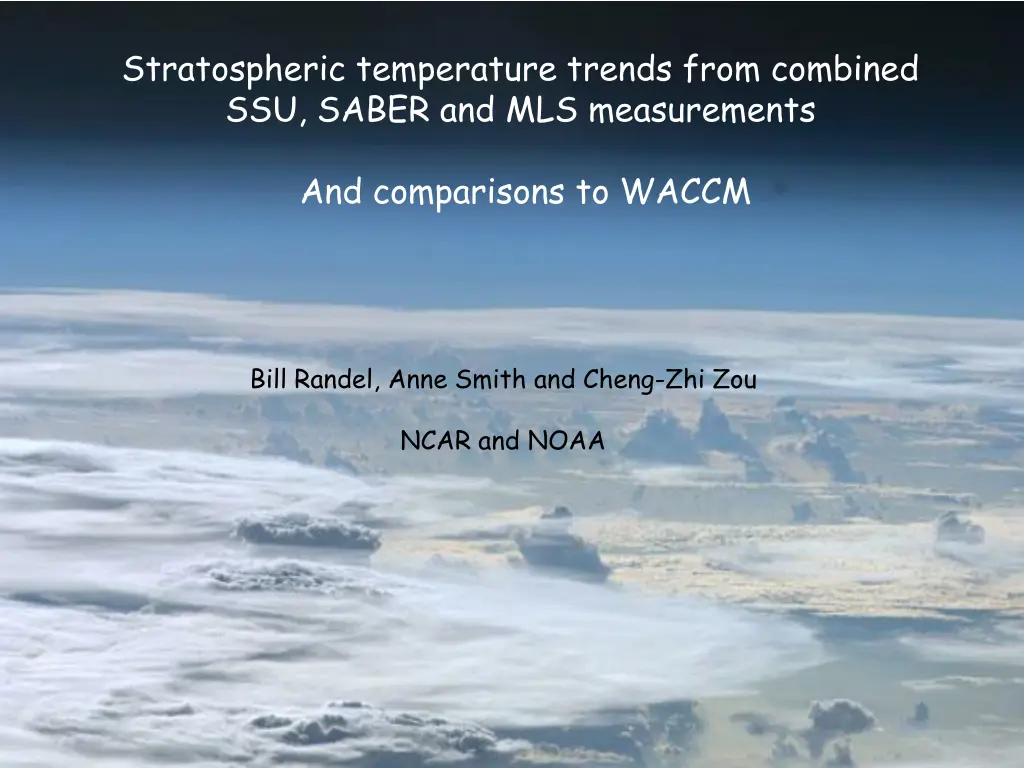
Analyzing Stratospheric Temperature Trends and Comparisons to WACCM
Explore the trends in stratospheric temperature using combined SSU, SABER, and MLS measurements, along with comparisons to WACCM models. Detailed data analysis and observations provide insights into temperature variations from 1979 to present.
Download Presentation

Please find below an Image/Link to download the presentation.
The content on the website is provided AS IS for your information and personal use only. It may not be sold, licensed, or shared on other websites without obtaining consent from the author. If you encounter any issues during the download, it is possible that the publisher has removed the file from their server.
You are allowed to download the files provided on this website for personal or commercial use, subject to the condition that they are used lawfully. All files are the property of their respective owners.
The content on the website is provided AS IS for your information and personal use only. It may not be sold, licensed, or shared on other websites without obtaining consent from the author.
E N D
Presentation Transcript
Stratospheric temperature trends from combined SSU, SABER and MLS measurements And comparisons to WACCM Bill Randel, Anne Smith and Cheng-Zhi Zou NCAR and NOAA
Objective: extend NOAA v2 SSU data record with SABER and MLS observations SSU 1979- 2006 (April) SABER 2002 (Feb)-2015 (continuing) MLS 2004 (Sept)-2015 (continuing) direct overlap for Sept 2004 April 2006
Data details: SSU: NOAA v2 (Zhou et al, 2014, JGR) Nadir viewing CO2 emission radiometers Recalibrated and merged NOAA operational data SABER Limb emission viewing geometry Broadband radiometry, T(p) derived from CO2 emissions Coverage: 50o S 80o N / 80o S 50o N (60-day yaw cycles) Altitudes ~20-100 km; Vertical resolution ~2 km Aura MLS Limb emission viewing geometry T(p) derived from O2 microwave emissions Near-global coverage (82o N-S) on a daily basis Altitudes ~10-90 km; Vertical resolution ~3-4 km
Data analysis details: 1) Construct SSU-equivalent layer temperatures from SABER and MLS 2) Deseasonalize each data set using: 2002-2006 for SSU 2004-2008 for SABER 2004-2008 for MLS 3) Normalize all anomalies to zero for the overlap period: Sept. 2004 April 2006 4) Regression fits using standard multivariate model: (Jan 1979 Oct. 2014) linear trend, solar cycle, ENSO, QBO (2 orthogonal terms) + volcanic periods omitted from fits (volcanic effects as residuals)
comparison of deseasonalized anomalies: SSU channel 3 40o S blue: SABER black: SSU red: MLS differences
time series of anomalies at equator: combined SSU + MLS
residuals anomalies (black) and regression fit (red)
latitudinal structure of residuals for NOAA-8 SSU2: each curve shows one month during 1983-1984 persistent patterns suggest bias correction problem for NOAA-8 SSU2
residuals from regression fits (at equator) revised NOAA-8 SSU2 data (v2.1) original SSU data (v2.0)
global residuals global average anomalies P E
changing temperature trends in the upper stratosphere in response to ozone observed ozone in upper stratosphere Bourassa et al 2014 increase post-1995 decrease pre-1995
trends vs. latitude (linear trends for 1979-2014): MSU4 SSU1 SSU3
nearly identical results using MLS and SABER: 1979-2014 MSU4 SSU1 SSU3 black: SSU + MLS red: SSU + SABER
monthly-varying trends shading = statistically significant cooling in summer middle-high latitudes (K/decade) MSU4 -.2
upper stratosphere: strong cooling in NH summer SSU2 -.9 -.6 - -.6 + warming in Austral winter
trends in K/decade SSU3 SSU2 -.9 -.6 -.9 -.6 similar patterns for al 3 SSU channels SSU1 MSU4 -.9 -.2
upper stratosphere: SSU3 - .9
Comparisons with WACCM simulation CMIP5 RCP6.0
WACCM sampled like SSU, MSU4 WACCM observations
WACCM 1979-2014 WACCM trends 1979-2014 (K/decade) -1.0 -1.0 -1.0 observations WACCM MSU4 MSU4 SSU1 SSU1 SSU3 SSU3
observations MSU4 WACCM WACCM stronger cooling
upper stratosphere: SSU3 observations WACCM - .6 - .9 - .6 - .9 very different
WACCM solar cycle WACCM observations SSU3 SSU3 MSU4 quite MSU4 reasonable agreement
Key points: SABER and MLS show nearly identical variability (and trends when combined with SSU) Observed trends for 1979-2014: Small trends in lower stratosphere Upper stratosphere: global cooling, except for high latitude SH Warming in Antarctic winter upper stratosphere (!) Comparisons with WACCM: Overall consistent with observations, but: Much stronger ozone hole cooling in LS Global cooling in upper stratosphere (no Antarctic winter warming)
What is causing the wintertime warming over Antartica? 2 hPa wave forcing climatology increases in wave forcing from ERAinterim reanalysis 2 hPa wave forcing trends increasing wave forcing ??
Volcanic signals derived from residuals (avg. of first year after eruption) MSU4 MSU4 SSU3
another example: SSU channel 2 equator differences
